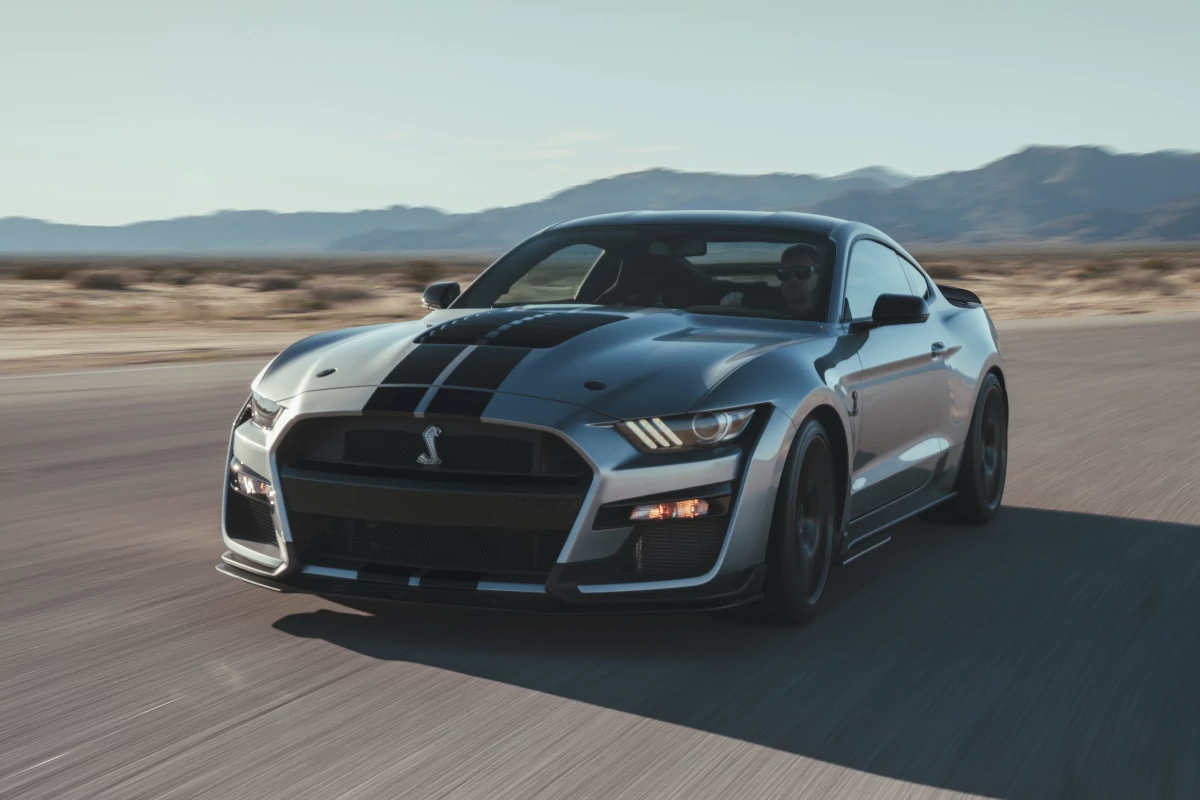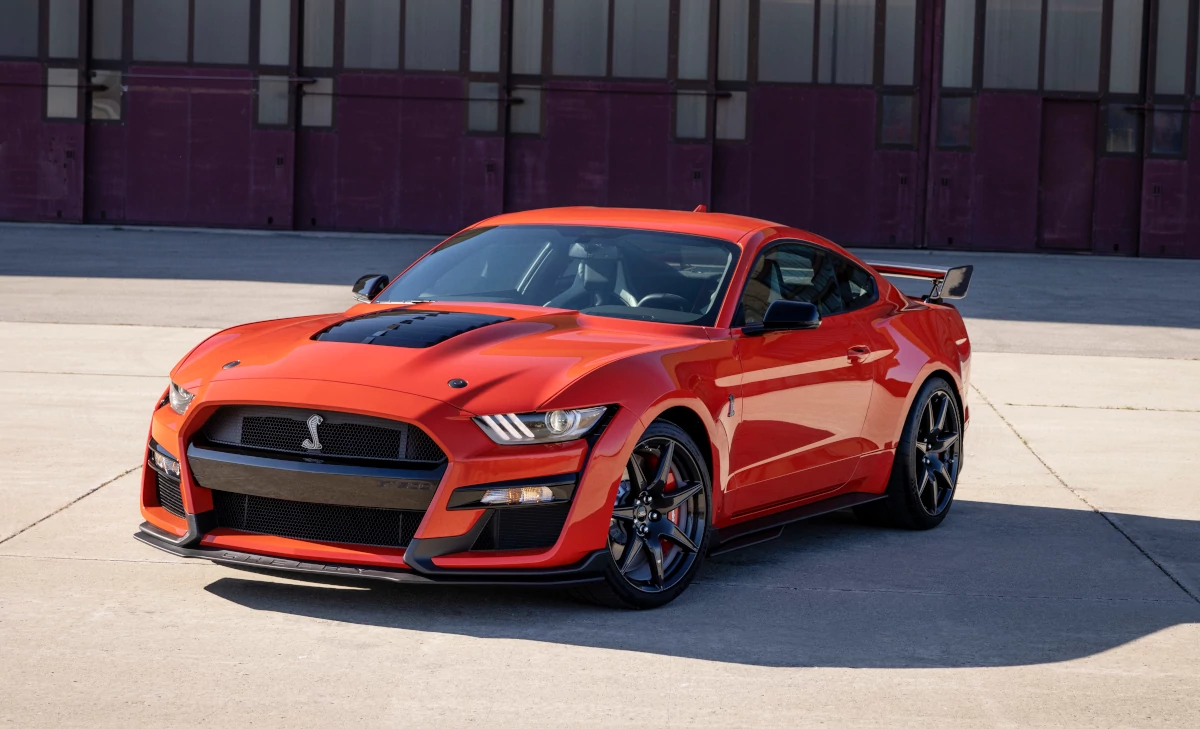Ford Mustang Shelby GT500 0-60 Time & Specs
The Mustang Shelby GT500 0-60 time is 3.4 seconds, as reported by both Car and Driver and MotorWeek.
That's nearly identical to the previous generation of Mustang Shelby GT500, despite the fact that it has almost 100 more horsepower. We'll get into that, but first let's see what the GT500 is equipped with.
GT500 0-60 Time & Specs

- 0 to 60 time: 3.4 seconds
- 1/4 Mile: 11.3 seconds
- Engine: 5.2 Liter Supercharged V8
- Transmission: 7-speed automatic (7AM)
- Drivetrain: Rear-Wheel Drive (RWD)
- Body Style: Coupe
- Horsepower: 760 HP
- Torque: 625 lb-ft
- Price: $76,820 (2022)
The latest iteration of the Shelby GT500, launched in 2020 and produced through through 2022, marks a high point in Ford's legacy of muscle cars, marrying immense horsepower with advanced technology to deliver stellar performance.
At the heart of the GT500 lies a 5.2-liter supercharged V8 engine, celebrated as one of the most powerful engines Ford has ever produced, delivering a formidable 760 horsepower.
This engine is paired with a cutting-edge 7-speed dual-clutch automatic transmission, enabling the GT500 to sprint from 0 to 60 mph in just 3.4 seconds, making it one of the fastest muscle cars available today.
The car also excels in quarter-mile races, clocking in at 11.3 seconds, which highlights its remarkable capabilities in straight-line speed.
The GT500 is designed not just for raw speed but also for refined handling.
It features an advanced suspension setup and aerodynamic modifications to maintain stability and responsiveness, whether it's on everyday roads or the race track.
The vehicle's rear-wheel-drive configuration adds to its dynamic driving experience, merging the thrill of traditional muscle cars with modern performance standards.

The exterior of the GT500 is as striking as its performance.
It sports a unique Shelby body kit, including a larger front grille to improve cooling, a rear spoiler for enhanced downforce, and special wheels fitted with high-performance brakes for superior stopping power.
Inside, the cabin reflects the car's sporty exterior, with Recaro racing seats, a flat-bottom steering wheel, and distinctive Shelby branding, creating an environment that resonates with the car's high-performance ethos.
Mustang Shelby 0-60 Time vs Previous Generation
Despite advancements, the Mustang Shelby's 0-60 time shows a minimal improvement over its predecessor, shaving off only .1 second. This raises the question: why is there such a marginal gain?
A notable trend among high-performance vehicles is the plateauing of acceleration times, typically around the 3.5-second mark, despite the introduction of additional horsepower.
This phenomenon isn't exclusive to the Mustang Shelby and can be observed in models like the Hellcats and the rear-wheel-drive Audi R8.
The root of this issue lies in the rear-wheel-drive system's limitations in efficiently transferring all that power to the ground, often resulting in wheelspin that hampers quick acceleration.
However, when it comes to higher speeds, the current Mustang Shelby does outshine its 2013 counterpart, particularly with an improved quarter-mile time by approximately half a second.
This indicates that once the Shelby overcomes initial traction challenges, its enhanced power and aerodynamics come into play, allowing for superior performance.
A significant change in the latest GT500 generation is the absence of a manual transmission option, a feature that was available in the previous generation.
This omission has been a point of contention among purists who value the engagement and control offered by a manual gearbox.
Mustang Shelby GT500 0-60 Time vs Rivals

With the Shelby Mustang GT500 being Ford's highest-performing Mustang, it naturally competes with the highest-performing variants of the other 2 American Muscle car coupes: The Dodge Challenger SRT Hellcat, and the Chevy Camaro ZL1.
Camaro ZL1 1LE
- 0 to 60 time: 3.4 seconds
- 1/4 Mile: 11.5 seconds
- Model: Camaro ZL1
- Engine: 6.2 Liter Supercharged V8
- Power: 650 horsepower and 650 lb-ft of torque
- Transmission: 10-speed automatic (10A)
- Drivetrain: Rear-Wheel Drive (RWD)
- Body Style: Coupe
- Price: $63,000 (2022)
Despite the Camaro's larger engine displacement, the GT500's engine produces a higher output of 760 HP, surpassing the ZL1 1LE.
On the aspect of torque, the ZL1 1LE has an advantage with an additional 25 lb-ft over the GT500.
In terms of transmission, the GT500 incorporates a 7-speed dual-clutch automatic transmission, designed for quick shifts, while the ZL1 1LE utilizes a 10-speed automatic transmission, aimed at optimizing a balance between performance and efficiency.
Both the GT500 and the ZL1 1LE report a 0 to 60 mph acceleration time of approximately 3.4 seconds.
However, in quarter-mile performance, the GT500 completes the distance slightly quicker at 11.3 seconds, compared to the ZL1 1LE's 11.5 seconds.
The drivetrain configuration for both vehicles is a rear-wheel drive (RWD) setup, typical of high-performance muscle cars.
Regarding pricing, the 2022 ZL1 1LE cost over $10,000 less than the GT500, giving it a far superior price/performance ratio.
Additionally, the ZL1 1LE offers a convertible option and, at the time of writing, remains in production.
Dodge Challenger SRT Hellcat Redeye

- 0 to 60 time: 3.7 seconds
- 1/4 Mile: 11.8 seconds
- Engine: 6.2 Liter Supercharged V8
- Transmission: 8-speed automatic (8A)
- Drivetrain: Rear-Wheel Drive (RWD)
- Body Style: Coupe
- Horsepower: 797 HP
- Torque: 707 lb-ft
- Price: $84,640 (2022)
The Hellcat Redeye commands the lead in horsepower, generating an impressive 797 HP compared to the GT500's 760 HP, and further establishes its dominance with a higher torque of 707 lb-ft over the GT500's 625 lb-ft. This indicates the Hellcat Redeye's superior low-end power delivery.
In the realm of transmissions, the GT500 opts for a 7-speed dual-clutch automatic, celebrated for its swift shifting, contrasting with the Hellcat Redeye's choice of an 8-speed automatic transmission.
Despite the Hellcat Redeye's power advantage, the GT500 takes the lead in acceleration, achieving 0 to 60 mph in 3.4 seconds against the Hellcat Redeye's 3.7 seconds, and also outpaces it in the quarter-mile run with a time of 11.3 seconds to the Hellcat's 11.8 seconds, underscoring the GT500's edge in straight-line performance.
Both cars share a rear-wheel drive layout, but the Hellcat Redeye offers a broader array of trims including the Widebody, Jailbreak, and Superstock, each consistent in acceleration performance and none eclipsing the GT500's speed.
Uniquely, the Hellcat presents a six-speed manual transmission option, albeit marginally slower by .2 seconds compared to its automatic counterpart.
Conclusion
The Mustang Shelby GT500 hardly improves upon the previous generation's acceleration while regrettably dropping the manual transmission. A switch to AWD is likely required to move the needle at this point.
With regards to its rivals, the ZL1 offers similar performance at a much better price, and can still be purchased new. The Challenger is much more expensive and slower but does offer a manual transmission option.
From an aesthetic point of view, the Shelby is easily the most attractive of the 3, which certainly counts for something when buying a car in this price range.
Frequently Asked Questions
Why is the GT500 limited to 180 mph?
The GT500's top speed is electronically limited to 180 mph. This limitation is often in place due to safety concerns, tire ratings, and to preserve the mechanical integrity of the car over time.
High speeds can place extreme stress on various components, including tires, which may not be rated for speeds beyond this limit.
Moreover, at speeds above 180 mph, aerodynamic and stability factors become increasingly critical, requiring additional engineering solutions that may not align with the intended use or design philosophy of the car.
How fast is a stock Shelby GT500?
A stock Shelby GT500, particularly the 2021 model, is known for its impressive performance, with a 0 to 60 mph time of approximately 3.4 seconds.
Its top speed is electronically limited to 180 mph, as previously mentioned.
These figures highlight the GT500's capabilities as a high-performance muscle car. Interestingly, the Carbon Fiber package does not appear to improve the acceleration of the Shelby GT500, suggesting that the stock GT500 is actually the fastest version.
Is the Dark Horse faster than the GT500?
The Mustang Dark Horse is not faster than the GT500.
It does achieve a 0-60 time of 3.7 seconds with an automatic transmission, which is within spitting distance of the GT500.
The manual-equipped option doesn't come close however, with a 0-60 time of 4.1 seconds.
What is the 0-60 time for a 1967 GT500?
The 1967 Shelby GT500, with its 428 cubic-inch V8 engine, had a 0 to 60 mph time of about 6.5 seconds. This performance was quite remarkable for its era, reflecting the GT500's position as a high-performance vehicle in the 1960s.
How fast is a Shelby GT500 without limiter?
Without the electronic speed limiter, it's theorized that the Shelby GT500 could potentially reach speeds well above 200 mph, considering its power output and aerodynamic design.
However, Ford has not officially released performance figures without the speed limiter, and removing or altering the limiter could pose safety risks and potentially affect the vehicle's warranty and legality for road use.
What is the fastest GT500 car?
The term "fastest" can refer to top speed, acceleration, or lap times, depending on context. In terms of straight-line speed, the latest models of the Shelby GT500 are the fastest.